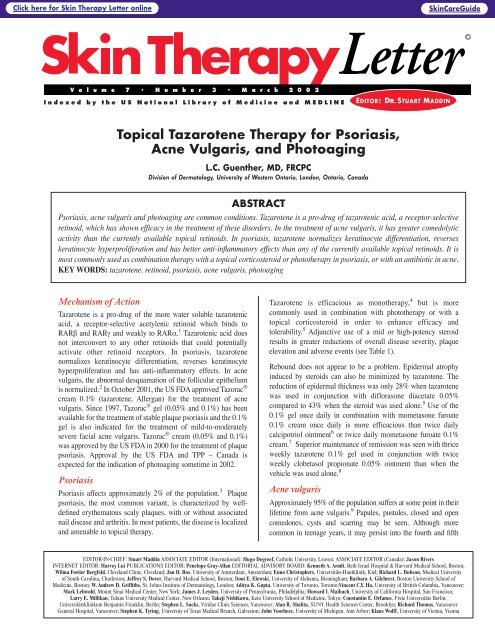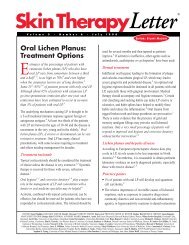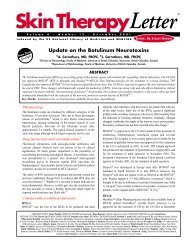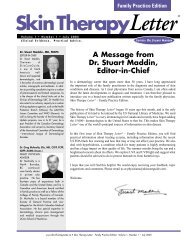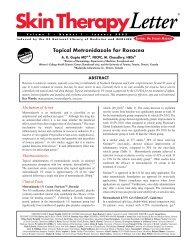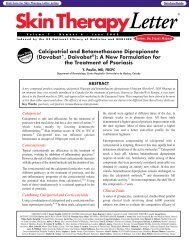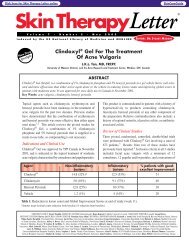Topical Tazarotene Therapy for Psoriasis, Acne Vulgaris, and ...
Topical Tazarotene Therapy for Psoriasis, Acne Vulgaris, and ...
Topical Tazarotene Therapy for Psoriasis, Acne Vulgaris, and ...
You also want an ePaper? Increase the reach of your titles
YUMPU automatically turns print PDFs into web optimized ePapers that Google loves.
Click here <strong>for</strong> Skin <strong>Therapy</strong> Letter onlineSkinCareGuideV o l u m e 7 • N u m b e r 3 • M a r c h 2 0 0 2Indexed by the US National Library of Medicine <strong>and</strong> MEDLINE<strong>Topical</strong> <strong>Tazarotene</strong> <strong>Therapy</strong> <strong>for</strong> <strong>Psoriasis</strong>,<strong>Acne</strong> <strong>Vulgaris</strong>, <strong>and</strong> PhotoagingL.C. Guenther, MD, FRCPCDivision of Dermatology, University of Western Ontario, London, Ontario, CanadaABSTRACT<strong>Psoriasis</strong>, acne vulgaris <strong>and</strong> photoaging are common conditions. <strong>Tazarotene</strong> is a pro-drug of tazarotenic acid, a receptor-selectiveretinoid, which has shown efficacy in the treatment of these disorders. In the treatment of acne vulgaris, it has greater comedolyticactivity than the currently available topical retinoids. In psoriasis, tazarotene normalizes keratinocyte differentiation, reverseskeratinocyte hyperproliferation <strong>and</strong> has better anti-inflammatory effects than any of the currently available topical retinoids. It ismost commonly used as combination therapy with a topical corticosteroid or phototherapy in psoriasis, or with an antibiotic in acne.KEY WORDS: tazarotene, retinoid, psoriasis, acne vulgaris, photoagingMechanism of Action<strong>Tazarotene</strong> is a pro-drug of the more water soluble tazarotenicacid, a receptor-selective acetylenic retinoid which binds toRARβ <strong>and</strong> RARγ <strong>and</strong> weakly to RARα. 1 Tazarotenic acid doesnot interconvert to any other retinoids that could potentiallyactivate other retinoid receptors. In psoriasis, tazarotenenormalizes keratinocyte differentiation, reverses keratinocytehyperproliferation <strong>and</strong> has anti-inflammatory effects. In acnevulgaris, the abnormal desquamation of the follicular epitheliumis normalized. 2 In October 2001, the US FDA approved Tazorac ®cream 0.1% (tazarotene, Allergan) <strong>for</strong> the treatment of acnevulgaris. Since 1997, Tazorac ® gel (0.05% <strong>and</strong> 0.1%) has beenavailable <strong>for</strong> the treatment of stable plaque psoriasis <strong>and</strong> the 0.1%gel is also indicated <strong>for</strong> the treatment of mild-to-moderatelysevere facial acne vulgaris. Tazorac ® cream (0.05% <strong>and</strong> 0.1%)was approved by the US FDA in 2000 <strong>for</strong> the treatment of plaquepsoriasis. Approval by the US FDA <strong>and</strong> TPP – Canada isexpected <strong>for</strong> the indication of photoaging sometime in 2002.<strong>Psoriasis</strong><strong>Psoriasis</strong> affects approximately 2% of the population. 3 Plaquepsoriasis, the most common variant, is characterized by welldefinederythematous scaly plaques, with or without associatednail disease <strong>and</strong> arthritis. In most patients, the disease is localized<strong>and</strong> amenable to topical therapy.<strong>Tazarotene</strong> is efficacious as monotherapy, 4 but is morecommonly used in combination with phototherapy or with atopical corticosteroid in order to enhance efficacy <strong>and</strong>tolerability. 5 Adjunctive use of a mid or high-potency steroidresults in greater reductions of overall disease severity, plaqueelevation <strong>and</strong> adverse events (see Table 1).Rebound does not appear to be a problem. Epidermal atrophyinduced by steroids can also be minimized by tazarotene. Thereduction of epidermal thickness was only 28% when tazarotenewas used in conjunction with diflorasone diacetate 0.05%compared to 43% when the steroid was used alone. 5 Use of the0.1% gel once daily in combination with mometasone furoate0.1% cream once daily is more efficacious than twice dailycalcipotriol ointment 6 or twice daily mometasone furoate 0.1%cream. 7 Superior maintenance of remission was seen with thriceweekly tazarotene 0.1% gel used in conjunction with twiceweekly clobetasol propionate 0.05% ointment than when thevehicle was used alone. 8<strong>Acne</strong> vulgarisApproximately 95% of the population suffers at some point in theirlifetime from acne vulgaris. 9 Papules, pustules, closed <strong>and</strong> opencomedones, cysts <strong>and</strong> scarring may be seen. Although morecommon in teenage years, it may persist into the fourth <strong>and</strong> fifthEDITOR-IN-CHIEF: Stuart Maddin ASSOCIATE EDITOR (International): Hugo Degreef, Catholic University, Leuven: ASSOCIATE EDITOR (Canada): Jason RiversINTERNET EDITOR: Harvey Lui PUBLICATIONS EDITOR: Penelope Gray-Allan EDITORIAL ADVISORY BOARD: Kenneth A. Arndt, Beth Israel Hospital & Harvard Medical School, Boston;Wilma Fowler Bergfeld, Clevel<strong>and</strong> Clinic, Clevel<strong>and</strong>; Jan D. Bos, University of Amsterdam, Amsterdam; Enno Christophers, Universitäts-Hautklinik, Kiel; Richard L. Dobson, Medical Universityof South Carolina, Charleston; Jeffrey S. Dover, Harvard Medical School, Boston; Boni E. Elewski, University of Alabama, Birmingham; Barbara A. Gilchrest, Boston University School ofMedicine, Boston; W. Andrew D. Griffiths, St. Johns Institute of Dermatology, London; Aditya K. Gupta, University of Toronto, Toronto;Vincent C.Y. Ho, University of British Columbia, Vancouver;Mark Lebwohl, Mount Sinai Medical Center, New York; James J. Leyden, University of Pennsylvania, Philadelphia; Howard I. Maibach, University of Cali<strong>for</strong>nia Hospital, San Francisco;Larry E. Millikan, Tulane University Medical Center, New Orleans; Takeji Nishikawa, Keio University School of Medicine, Tokyo; Constantin E. Orfanos, Freie Universitäts Berlin,Universitätsklinikum Benjamin Franklin, Berlin; Stephen L. Sacks, Viridae Clinic Sciences, Vancouver; Alan R. Shalita, SUNY Health Sciences Center, Brooklyn; Richard Thomas, VancouverGeneral Hospital, Vancouver; Stephen K. Tyring, University of Texas Medical Branch, Galveston; John Voorhees, University of Michigan, Ann Arbor; Klaus Wolff, University of Vienna, Vienna
ComparatorsResults<strong>Tazarotene</strong> 0.1% gel +:• There was a lower median time to reach 50% improvement with (2 weeks) or• Fluocinolone acetonide 0.01% cream (LOW) vs. HIGH (3 weeks) vs. placebo (4 weeks) (p
ComparatorsResults<strong>Tazarotene</strong> 0.1% gel q.d. vs. Retin A ® gel q.d. 15 0.025% <strong>Tazarotene</strong> was more efficacious in reducing open comedo count (65% vs.44%, p=0.03), total noninflammatory lesion count (55% vs. 42% p=0.04) <strong>and</strong>total inflammatory lesion count (54% vs. 44% NS)<strong>Tazarotene</strong> 0.1% gel q.d. vs. Retin A Micro ® 0.1% q.d. 16 There were statistically significant reductions in overall disease severity (36%vs. 26%, p=0.02), global response scores (2.80 vs. 3.35, p=0.02), <strong>and</strong>noninflammatory lesions (60% vs. 38%, p=0.02) with tazarotene.<strong>Tazarotene</strong> 0.1% gel q.d. vs. Differin ® Gel q.d. 17There was a greater reduction with tazarotene when compared to adapalene inmean global response score (2.38 vs. 3.41 at 12 weeks, p
Contraceptive counseling should be given to women ofchildbearing potential be<strong>for</strong>e topical tazarotene is used. Althoughabsorption is minimal, it should not be used by pregnant womensince systemic tazarotene is teratogenic.Conclusions<strong>Topical</strong> tazarotene is very efficacious in the treatment ofpsoriasis, acne <strong>and</strong> photoaging. It is the most potent comedolytictopical retinoid currently available. Combination therapy withcorticosteroids or phototherapy in psoriasis, or antibiotics in acnevulgaris, can enhance efficacy <strong>and</strong> tolerance. Irritation can beminimized with patient education, <strong>and</strong> use of the 0.05% cream,on alternate day <strong>and</strong> short-contact regimens.References1. Ch<strong>and</strong>raratna RA. <strong>Tazarotene</strong>—first of a new generation of receptor-selectiveretinoids. Br J Dermatol 135(Suppl 49):18-25 (1996 Oct).2. Bershad S, Poulin YP, Berson DS, et al. <strong>Topical</strong> retinoids in the treatment of acnevulgaris. Cutis 64(2 Suppl):8-20 (1999 Aug).3. Koo J. Population-based epidemiologic study of psoriasis with emphasis onquality of life assessment. Dermatol Clin 14(3):485-96 (1996 Jul).4. Weinstein GD, Krueger GG, Lowe NJ, et al. <strong>Tazarotene</strong> gel, a new retinoid <strong>for</strong>topical therapy of psoriasis: vehicle-controlled study of safety, efficacy <strong>and</strong>duration of therapeutic effect. J Am Acad Dermatol 37(1):85-92 (1997 Jul).5. Guenther L. <strong>Tazarotene</strong> combination treatments in psoriasis. J Am AcadDermatol 43(2 Pt 3):S36-42 (2000 Aug).6. Guenther LC, Poulin YP, Pariser DM. A comparison of tazarotene 0.1% gel oncedaily plus mometasone furoate 0.1% cream once daily versus calcipotriene0.005% ointment twice daily in the treatment of plaque psoriasis. Clin Ther22(10):1225-38 (2000 Oct).7. Koo J, Martin D. Double-blind comparison of tazarotene gel q.d. plusmometasone furoate cream q.d. versus mometasone furoate cream b.i.d. Posterpresentation at: American Academy of Dermatology annual meeting, (1999 July28-August 1), New York, NY.8. Lebwohl M, Lombardi K, Tan MH. Duration of improvement in psoriasis aftertreatment with tazarotene 0.1% gel plus clobetasol propionate 0.05% ointment:comparison of maintenance treatments. Int J Dermatol 40(1):64-6 (2001 Jan).9. Ho V, Schacter D, Miller R, et al. <strong>Acne</strong> management <strong>for</strong> the 90s: currenttreatment guidelines. Can J Diagnosis 12(suppl):1-25 (1995).10. Lebwohl MG, Breneman DL, Goffe BS, et al. <strong>Tazarotene</strong> 0.1% gel pluscorticosteroid cream in the treatment of plaque psoriasis. J Am Acad Dermatol39(4 Pt 1):590-6 (1998 Oct).11. Green L, Sadoff W, <strong>and</strong> the <strong>Tazarotene</strong> Plus High-Potency or Mid-PotencySteroid Study Group. A clinical evaluation of tazarotene 0.1% gel, with <strong>and</strong>without a high- or mid-high-potency corticosteroid, in patients with stableplaque psoriasis. J Cut Med Surg. In Press 2002.12. Koo JY, Lowe NJ, Lew-Kaya DA, et al. <strong>Tazarotene</strong> plus UVB phototherapy inthe treatment of psoriasis. J Am Acad Dermatol 43(5 Pt 1):821-8 (2000 Nov).13. Behrens S, Grundmann-Kollmann M, Schiener R, Peter RU, Kerscher M.Combination phototherapy of psoriasis with narrow-b<strong>and</strong> UVB irradiation <strong>and</strong>topical tazarotene gel. J Am Acad Dermatol 42(3):493-5 (2000 Mar).14. Behrens S. Combination treatment of psoriasis with photochemotherapy <strong>and</strong>tazarotene gel, a receptor-selective topical retinoid. (Letter to Ed.) Br J Dermatol141:154-179 (1999).15. Webster GF, Berson D, Stein LF, Fivenson DP, Tanghetti EA, Ling M. Efficacy<strong>and</strong> tolerability of once-daily tazarotene 0.1% gel versus once-daily tretinoin0.025% gel in the treatment of facial acne vulgaris: a r<strong>and</strong>omized trial. Cutis67(6 Suppl):4-9 (2001 Jun).16. Leyden JJ, Tanghetti EA, Miller B, et al. Once-daily tazarotene 0.1% gel versusonce-daily tretinoin 0.1% microsponge gel <strong>for</strong> the treatment of facial acnevulgaris: a double-blind r<strong>and</strong>omized trial. Cutis 69(suppl 2):12-19 (2002).17. Webster GF, Guenther L, Poulin YP, et al. A multicenter, double-blind,r<strong>and</strong>omized comparison study of the efficacy <strong>and</strong> tolerability of once-dailytazarotene 0.1% gel <strong>and</strong> adapalene 0.1% gel <strong>for</strong> the treatment of facial acnevulgaris. Cutis 69(suppl 2):4-11 (2002).18. Leyden J, Lowe N, Kakita L, Draelos Z. Comparison of treatment of acne vulgariswith alternate-day applications of tazarotene 0.1% gel <strong>and</strong> once-daily applicationsof adapalene 0.1% gel: a r<strong>and</strong>omized trial. Cutis 67(6 suppl):10-6 (2001 Jun).19. Draelos ZD, Tanghetti EA, <strong>and</strong> the <strong>Tazarotene</strong> Combination Leads to Efficacious<strong>Acne</strong> Results (CLEAR) Trial Study Group. Cutis 69(suppl 2):20-29 (2002).20. Sefton J, Kigman AM, Kopper SC, Lue JC, Gibson JR. Photodamage pilot study:a double-blind, vehicle-controlled study to assess the efficacy <strong>and</strong> safety oftazarotene 0.1% gel. J Am Acad Dermatol 43(4):656-63 (2000 Oct).21. Kang S, Leydon JJ, Lowe NJ, et al. <strong>Tazarotene</strong> cream <strong>for</strong> the treatment of facialphotodamage: a multicenter, investigator-masked, r<strong>and</strong>omized, vehiclecontrolled,parallel comparison of 0.01%, 0.025%, 0.05%, <strong>and</strong> 0.1% tazarotenecreams with 0.05% tretinoin emollient cream applied once daily <strong>for</strong> 24 weeks.Arch Dermatol 137(12):1597-604 (2001 Dec).————— INDUSTRY NEWS —————Roche Initiates an Enhanced Pregnancy Prevention Programto Prevent Accutane- Exposed PregnanciesIn January 2002, Hoffmann-LaRoche, working closely with the US FDA distributed an enhanced version of their Pregnancy Prevention Program <strong>for</strong> Womenon Accutane ® to more than 375,000 dermatologists, primary care prescribers <strong>and</strong> pharmacists in the US. The program is called S.M.A.R.T. (System to ManageAccutane ® Related Teratogenicity). It involves the prescriber, pharmacist <strong>and</strong> patient to ensure that female patients are not pregnant when they begin takingAccutane ® <strong>and</strong> that they do not become pregnant while taking the medication <strong>and</strong> <strong>for</strong> one month after stopping treatment. An innovative component of theprogram is the use of yellow self-adhesive Accutane ® Qualifications Stickers, which prescribers will apply to all Accutane ® prescriptions.To receive the first Accutane ® prescription, the female patient will be required to meet four qualifications:1. Have two negative pregnancy tests – the first as a screening test <strong>and</strong> the second as a confirmation test that will be administered during the first 5 daysof her next menstrual period.2. Select <strong>and</strong> commit to using two effective <strong>for</strong>ms of birth control simultaneously one month prior to treatment, during treatment <strong>and</strong> <strong>for</strong> one month afterstopping treatment.3. Read <strong>and</strong> sign an in<strong>for</strong>med consent agreement explaining the risk of potential birth defects associated with Accutane ® .4. Learn about <strong>and</strong> be encouraged to enroll in the Accutane ® Survey, a system to track female Accutane ® patients, learn about their experiences withpregnancy prevention ef<strong>for</strong>ts <strong>and</strong> determine their pregnancy status.Each month the patient must have a negative pregnancy test <strong>and</strong> receive contraception counseling from the prescriber be<strong>for</strong>e receiving a new prescription.If the patient meets these qualifications, or is male, the prescriber will then write a prescription <strong>for</strong> a 1-month supply, affix one of the yellow Accutane ®Qualification Stickers <strong>and</strong> date it. Prescriptions must be filled within 7 days of the qualification date on the sticker.This program is being phased in <strong>and</strong> the deadline <strong>for</strong> compliance is April 10, 2002.The S.M.A.R.T. program is only applicable <strong>for</strong> treating patients in the US. For other countries, including Canada, Roche has created uniquely tailoredprograms to address their distinctive health care needs.4Skin <strong>Therapy</strong> Letter • Editor: Dr. Stuart Maddin • Vol. 7 No. 3 • March 2002
Common Sense Dermatological Drug SuggestionsFor Women Who Are Breast-feedingC. Zip, MD, FRCPCDepartment of Medicine, University of Calgary, Calgary, Alberta, CanadaABSTRACTUse of medications by breast-feeding mothers is not uncommon. When prescribing a medication to a nursing mother, the physicianmust weigh the potential risk of exposing the infant to the medication or the risks of not breast-feeding against the benefits of themedication to the mother. In<strong>for</strong>mation regarding the safety of common dermatological medications during lactation will bereviewed. Based on this in<strong>for</strong>mation, treatment recommendations will be made.Key Words: breast-feeding, antimicrobials, antihistimines, immunomodulators, antipsoriatics, steriods, scabicides, anti-acne agentsBreast-feeding provides optimal nutrition in the first 6 months oflife. Well documented benefits of breast-feeding include adecreased incidence of infantile diarrhea 1 <strong>and</strong> infection. 2 Otherstudies show a possible protective affect against sudden infantdeath syndrome, 3 insulin dependent diabetes mellitus, 4 Crohn’sdisease, 5 ulcerative colitis, 5 lymphoma, 6 <strong>and</strong> allergic disorders. 7The American Academy of Pediatrics (AAP) recommendsexclusive breastfeeding <strong>for</strong> the first six months of life, continuingto a year or beyond with the addition of solid food at 6 months ofage. 8 In Canada, approximately 80% of new mothers initiatebreast-feeding, 9 while 30-40% are still nursing 6 monthspostpartum. 10 Corresponding US figures are 64% <strong>and</strong> 29%,respectively. 11The use of prescription <strong>and</strong> over-the-counter (OTC) medicationsis common <strong>for</strong> nursing mothers. In one study of 14,000 pregnantor breastfeeding women, 79% of them took at least onemedication, while on average, 3.3 drugs were taken whilebreastfeeding. 12 Fortunately, severe adverse effects resultingfrom the presence of common medications in breast milk areuncommon. Of 838 infants exposed to medications throughbreast milk, 11% experienced minor reactions, <strong>and</strong> no seriousreactions requiring medical attention or cessation ofbreastfeeding occurred. 13 The adverse reactions that did occurwere consistent with the known pharmacological affects of thecausative agent.Transfer of Medications into Breast MilkA number of factors determine the passage of a drug into breastmilk. These include characteristics of the mother, the infant <strong>and</strong>the drug itself. In general, drugs given to a nursing mother reachthe infant in much lower concentrations than those given to apregnant woman reach the fetus. 14AntimicrobialsPenicillins <strong>and</strong> cephalosporins are present only in trace amountsin breast milk, <strong>and</strong> are compatible with breast-feeding. 15 Theiruse is associated with a remote risk of alterations ingastrointestinal flora causing diarrhea <strong>and</strong> allergic sensitization ofthe infant. 16 Erythromycin is excreted into breast milk, but noadverse effects in infants exposed to this drug in breast milk havebeen reported, 16 <strong>and</strong> it is considered compatible withbreastfeeding by the AAP. Caution may be in order in whenprescribing erythromycin to lactating mothers of newbornshowever, because of recent reports of pyloric stenosis in neonatestreated with erythromycin. 17,18 It has been reported that thecalcium present in breast milk may inhibit absorption of the smallamount of tetracycline, however, use of tetracycline while breastfeedingis not advised, because the threshold <strong>for</strong> its affect on teeth<strong>and</strong> bone is unknown. 14 <strong>Topical</strong> clindamycin is partially absorbedthrough the skin <strong>and</strong> small amounts may pass into breast milk. Noproblems have been reported in nursing infants with maternal useof topical clindamycin, 19 although bloody diarrhea was reportedin an infant of a mother on intravenous clindamycin. 20 Noadverse effects on the infant have been reported with use oftopical metronidazole during lactation, however the manufactureradvises against its use while breast-feeding. 21Acyclovir is considered safe during breast-feeding. 15,16Experience with the use of valacyclovir <strong>and</strong> famciclovir duringhuman lactation is lacking. 16Terbinafine <strong>and</strong> itraconazole are both excreted in breast milk, <strong>and</strong>the safety of their use during lactation is unknown. Parenteralfluconazole has been safely used in neonates with c<strong>and</strong>idiasis,<strong>and</strong> based on this, Briggs states that its use is probably safeduring breast-feeding. 16 The manufacturers of these threeantifungals do not recommend their use while breast-feeding <strong>and</strong>the AAP has no rating. 22,23,24AntihistaminesSmall amounts of antihistamines are excreted in breast milk.Their use is not recommended during breast-feeding becauseinfants may be more susceptible to their adverse effects,particularly drowsiness <strong>and</strong> irritability. 19,25 Antihistamines mayalso reduce milk production in some women.ImmunomodulatorsBoth cyclosporine <strong>and</strong> methotrexate are excreted into breast milk,<strong>and</strong> considered contraindicated during breast-feeding by the AAPbecause of the possibility of immunosuppression, neutropenia,carcinogenesis <strong>and</strong> unknown affects on growth. 15Hydroxychloroquine is excreted in small amounts in breast milk<strong>and</strong> because of its slow elimination rate <strong>and</strong> potential toaccumulate to toxic levels in infants, caution is advised with dailySkin <strong>Therapy</strong> Letter • Editor: Dr. Stuart Maddin • Vol. 7 No. 3 • March 2002 5
dosing. 26 The AAP, however, considers hydroxychloroquine to becompatible with breast-feeding. 15 Tacrolimus is excreted in humanmilk. <strong>Topical</strong> tacrolimus is not recommended by the manufacturerduring breastfeeding, because of the potential <strong>for</strong> systemicabsorption with topical use. 27 The AAP does not rate tacrolimus.AntipsoriaticsIt is not known whether calcipotriol is excreted into breast milk.The manufacturer recommends its use only if the anticipatedbenefits outweigh the potential risks. 28 Methoxsalen excretion inhuman milk is also unknown <strong>and</strong> although there are no reports ofadverse effects with its use during lactation, the manufacturerrecommends use only when the probable benefits outweigh thepotential risks. 29 Briggs recommends that breast-feeding beinterrupted <strong>for</strong> at least 24 hours after administration of the drugbecause of its photosensitizing affect. 16SteroidsTrace amounts of prednisone <strong>and</strong> its metabolite prednisolone areexcreted in breast milk. 16 The AAP considers prednisone to becompatible with breastfeeding. 15 Hypertension was reported inthe infant of a woman who used a corticosteroid on the nipples. 30Use of topical corticosteroids on the breasts prior to nursingshould be avoided.Because estrogen decreases the quantity <strong>and</strong> protein content ofbreast milk, the use of combination oral contraceptive pillsshould be avoided whenever possible in lactating mothers,especially in the first two months postpartum. 31ScabicidesIt is not known if permethrin is excreted in human milk. Citingevidence of teratogenicity in animals, the manufacturerrecommends temporary discontinuation of nursing or avoidanceduring lactation. 32 Anderson considers its use to be safe duringlactation. 33AnalgesicsSignificant salicylate levels have been found in breast-fed neonatesof mothers taking salicylates, raising concerns about metabolicacidosis, bleeding, altered pulmonary circulation <strong>and</strong> Reye’ssyndrome. 26 There is one report of salicylate intoxication in aninfant exposed through her mother’s milk. 34 The AAPrecommends that it be used with caution in nursing mothers. 15Widespread use of topical salicylic acid should be avoided becauseof the potential <strong>for</strong> significant systemic absorption. Of thenonsteroidal anti-inflammatories, ibuprofen <strong>and</strong> flurbiprofen havethe best documentation of safety during lactation because they donot enter breast milk in significant quantities. 14 The AAPconsiders ibuprofen, indomethacin, <strong>and</strong> naprosyn to be compatiblewith breast-feeding. 15 There is one case report of seizures in aninfant exposed to indomethacin through breast milk. 35Antiacne AgentsThere have been no reports of adverse effects from use of topicalbenzoyl peroxide <strong>and</strong> topical tretinoin during lactation. 19 It is notknown whether adapalene or tazarotene pass into breast milk.The manufacturers recommend caution with their use duringClass of Choices Compatible CommentMedication with Breast-FeedingAntibiotics Penicillins, Cephalosporins, Possibility of diarrhea, thrush <strong>and</strong> allergic sensitization of theErythromycin (caution with neonates), infant<strong>Topical</strong> clindamycin, <strong>Topical</strong>metronidazoleAntivirals Acyclovir Considered safe during breastfeedingAntifungals Fluconazole Manufacturer does not recommend its use during lactation.Antihistamines None Infants may be more susceptible to their adverse effectsImmunomodulators Hydroxychloroquine Methotrexate <strong>and</strong> cyclosporine are not recommendedAntipsoriatics Calcipotriol No reports of adverse effectsSteroids Prednisone Trace amounts of prednisone are present in breast milk.<strong>Topical</strong> corticosteroidsCombination oral contraceptivesAvoid use of topical corticosteroids on breasts prior to nursing.Delay use until milk production established; may reduce milkproduction.Scabicides Permethrin Probably safe; consider temporary discontinuation ofbreastfeeding.Analgesics Ibuprofen Ibuprofen does not enter breast milk in significant amounts.Acetaminophen 15Antiacne Benzoyl peroxide No reports of adverse effects<strong>Topical</strong> tretinoinTable 1: Compatibility of some dermatologic drugs during breastfeeding.6Skin <strong>Therapy</strong> Letter • Editor: Dr. Stuart Maddin • Vol. 7 No. 3 • March 2002
lactation. 36,37 Spironolactone may pass into breast milk, but hasnot been reported to cause problems in nursing babies. 19 TheAAP considered spironolactone to be compatible with breastfeeding,15 although its use during lactation is not recommendedby the manufacturer. 38ConclusionWhen considering a medication <strong>for</strong> a lactating mother, thebenefits of breast-feeding need to be weighed against thepotential risk of exposure of the infant to the drug in question.For the majority of dermatological conditions, alternatives thatare compatible with breast-feeding are available, or treatment canbe safely postponed until lactation is completed.References1. Popkin BM, Adair L, Akin JS, et al. Breast-feeding <strong>and</strong> diarrheal morbidity.Pediatrics 1990; 86: 874-882.2. Beaudry M., Dufour R, Marcoux S. Relation between infant feeding <strong>and</strong>infections during the first six months of life. J Pediatr 1995; 126: 191-197.3. Ford RPK, Taylor BJ, Mitchell EA, et al. Breastfeeding <strong>and</strong> the risk of suddeninfant death syndrome. Int J Epidermiol 1993; 22: 885-890.4. Mayer EJ, Hamman RF, Gay EC, et al. Reduced risk of IDDM among breast-fedchildren. Diabetes 1988; 37:1625-1632.5. Rigas A, Rigas B, Glassman M, et al. Breast-feeding <strong>and</strong> maternal smoking inthe etiology of Crohn’s disease <strong>and</strong> ulcerative colitis in childhood. AnnEpidemiol 1993; 3:387-392.6. Davis MK, Savitz DA, Graubard BI. Infant feeding <strong>and</strong> childhood cancer. Lancet1988; 2:365-368.7. Gdalevich M, Mimouni D, David M, Mimouni M. Breast-feeding <strong>and</strong> the onsetof atopic dermatitis in childhood: A systematic review <strong>and</strong> meta-analysis ofprospective studies. J Am Acad Dermatol 2001; 45: 520-527.8. American Academy of Pediatrics, Work Group on Breastfeeding. Breastfeeding<strong>and</strong> the use of human milk. Pediatrics 1997; 100: 1035-1039.9. Barber CM, Abernathy T, Steinmetz B, Charlebois J. Using a breastfeedingprevalence survey to identify a population <strong>for</strong> targeted programs. Can J PublicHealth 1997; 88:242-245.10. Bourgoin G, Lahaie N, Rheaume B, et al. Factors influencing the duration ofbreastfeeding in the Sudbury region. Can J Public Health 1997; 88: 238-241.11. Ryan AS. The resurgence of breastfeeding in the United States. Pediatrics1997; 99:E12.12. Collaborative Group on Drug Use in Pregnancy. Medication during pregnancy:An intercontinental cooperative study. Int J Gynecol Obstet 1992; 39:185–196.13. Ito S, Blajchman A, Stephenson M, et al. Prospective follow-up of adversereactions in breastfed infants exposed to maternal medication. Am J ObstetGynecol 1993; 168:1393-1399.14. Howard CR, Lawrence RA. Drugs <strong>and</strong> breastfeeding. Clin Perinatology 1999;26: 447-478.15. American Academy of Pediatrics Committee on Drugs. The transfer of drugs <strong>and</strong>other chemicals into human milk. Pediatrics 1994; 93:137-150.16. Briggs GG, Freeman RK, Yaffee SL. Drugs in pregnancy <strong>and</strong> lactation, FifthEdition, Baltimore: Williams <strong>and</strong> Wilkins, 1998.17. Anonymous. Erythromycin – induced pyloric stenosis in infants. PrescrireInternational 2001; 10:16.18. Honein MA, Paulozzi LJ, Himelright IM, et al. Infantile hypertrophic pyloricstenosis after pertussis prophylaxis with erythromycin: A case review <strong>and</strong> cohortstudy. Lancet 1999; 354: 2101-2105.19. USP- DI. Drug In<strong>for</strong>mation <strong>for</strong> the Health Care Professional, Vol. 1, NineteenthEdition, Taunton, MA: R<strong>and</strong> McNally, 1999.20. Mann CF. Clindamycin <strong>and</strong> breast-feeding. Pediatrics 1980; 66:1030-1031.21. Metronidazole product monograph, Galderma Canada Inc., Thornhill, ON,Canada, 1996.22. Terbinafine product monograph, Novartis Pharmaceuticals Canada Inc., Dorval,QC, Canada, 2002.23. Itraconazole product monograph, Janssen-Ortho Inc., Toronto, ON, Canada, 2002.24. Fluconazole product monograph, Pfizer Canada Inc., Kirkl<strong>and</strong>, QC, Canada, 2001.25. Reed BR, Dermatologic drug use during pregnancy <strong>and</strong> lactation. DermatolClinics 1997; 15:197-202.26. Janssen NM, Genta MS. The effects of immunosuppressive <strong>and</strong> antiinflammatorymedications on fertility, pregnancy <strong>and</strong> lactation. Arch Intern Med2000; 160:610-619.27. Tacrolimus product monograph, Fujisawa Canada Inc., Markham, ON,Canada, 2001.28. Calcipotriol product monograph, Leo Pharma Inc., Thornhill, ON, Canada, 2001.29. Methoxsalen product monograph, ICN Canada Ltd. Montreal, QC, Canada, 1992.30. DeStefano P, Bongo C, Borgna – Pignatti C, et al. Factitious hypertension withmineralocorticoid excess in infants. Helv Paediatr Acta 1983; 38:185-189.31. Spencer JP,Gonzalez LS, Barnhart DJ. Medications in the breast-feedingmother. Am Fam Phys 2001; 64:119-126.32. Permethin product monograph, Glaxo Smith Kline,Mississauga, ON, Canada, 2002.33. Anderson PO. Drug use during breast-feeding. Clin Pharm 1991; 10:594-624.34. Clark JH, Wilson WG. A 16-day-old breast-fed infant with metabolic acidosiscaused by salicylate. Clin Pediatr 1981; 20:53-54.35. Eeg-Olofsson O,Malmros I, Elwin CE, Steen B. Convulsions in a breast-fedinfant after maternal indomethacin. Lancet 1978; 2:215.36. Adapalene product monograph, Galderma Canada Inc., Thornhill, ON,Canada, 2002.37. <strong>Tazarotene</strong> product monograph, Allergan, Markham, ON, Canada, 2001.38. Spironolactone product monograph, Pharmacia Canada Inc., Mississauga, ON,Canada, 2001.WE’RE ON THE NET! www.skincareguide.com————— INDUSTRY NEWS —————Schering-Plough Recalls Specific Lots of Claritin-D 12-hour TabletsIn February 2002, Shering-Plough announced a voluntary recall of specific lots of Claritin-D ® 12-hour (5mg loratidine/120mg pseudoephedrine sulfate)tablets directed to wholesale accounts <strong>and</strong> retail pharmacies. These products were manufactured between August 1999, <strong>and</strong> June 2001. They are indicated<strong>for</strong> the relief of symptoms of seasonal allergic rhinitis.Schering-Plough as part of its st<strong>and</strong>ard quality-control procedures conducted stability testing of specific lots of this product including dissolution tests todetermine the rate that tablets dissolve <strong>and</strong> the amount of active ingredients released. Test results indicated that some tablets in these lots did not demonstratefull release of pseudoephedrine at the 5 th hour per specification, although be 25 minutes later all tested samples met specifications <strong>for</strong> releasing thedecongestant component. The company believes that this short delay poses no medical risk to patients.This recall is being conducted with the knowledge of the US FDA.Skin <strong>Therapy</strong> Letter • Editor: Dr. Stuart Maddin • Vol. 7 No. 3 • March 2002 7
Update on DrugsClass Name/Company Approval Dates <strong>and</strong> CommentsAntiviral AgentNaturally-Derived AlphaInterferonViragenThe Swedish Regulatory Authorities approved exp<strong>and</strong>ed use in January2002, to include the treatment of patients afflicted with any <strong>and</strong> alldiseases in which patients were or became resistant to treatments usingrecombinant (synthetic) interferon. Recombinant interferons usuallycontain only one subtype of interferon as compared to multiplesubtypes in naturally derived interferon, which is produced by humanwhite blood cells.HIV/AIDSOralContraceptiveOncologicAgentHIV/AIDSAntihistamineEfavirenzSustiva ®Bristol-Myers SquibbEstradiol/LevonorgestrelAlesse ®Wyeth-Ayerst CanadaHSPPC-96Oncophage ®AntigenicsTenofovir Disoproxil FumerateViread ®Gilead SciencesDesloratidineClarinex ® 5mg. TabletsSchering-PloughThe US FDA approved a new one-tablet 600mg. <strong>for</strong>mulation inFebruary 2002, of this non-nucleoside reverse transcriptase inhibitorused in combination treatment <strong>for</strong> HIV. The new <strong>for</strong>mulation willprovide doctors with the option of prescribing one 600mg. tablet oncedaily instead of three 200mg. capsules once daily.TPP – Canada approved this birth control pill in January 2002, <strong>for</strong> thetreatment of moderate acne in women.The US FDA granted fast-track designation in February 2002, <strong>for</strong> thiscancer vaccine <strong>for</strong> the treatment of metastatic melanoma.The EMEA granted marketing approval in all 15 member states of theEuropean Union in February 2002, <strong>for</strong> use in combination with otherantiretroviral agents <strong>for</strong> the treatment of HIV infection in patients whoare experiencing early virological failure.The US FDA approved additional indications <strong>for</strong> this antihistaminein February 2002, to treat chronic idiopathic urticaria <strong>and</strong>symptoms of allergies caused by indoor <strong>and</strong> outdoor allergens inadults <strong>and</strong> children >12 years of age.Drug NewsHIV/AIDS Many scientists have believed that HIV acts to deplete its primary target, CD4+ T-cells by blocking new T-cell production. According to a report from the US National Institutes of Health, two independent studiesdemonstrated that HIV does not block such production, but acts to accelerate the division of existing T-cells. Consequently, the increases in CD4+ T-cell counts seen following highly active antiretroviral therapy(HAART) are not due to a boost in the production of new T-cells. Instead, they are caused by a slowdownin the loss of existing T-cells.SunscreensAccording to an article published in the Journal of the American Academy of Dermatology* sunscreenshould be reapplied 15-30 minutes after sun exposure begins <strong>for</strong> maximum benefit. An individual whodoes this will have 15-40% less exposure to ultraviolet rays than someone who waits <strong>for</strong> 2 hours be<strong>for</strong>ereapplying sunscreen.*J Amer Acad Dermatol 45:882-5 (2001).Skin <strong>Therapy</strong> Letter(ISSN 1201–5989) Copyright 2002 by SkinCareGuide.com. The Skin <strong>Therapy</strong> Letter © is published 10 times annually by SkinCareGuide.com Ltd, 450 – 688 West Hastings, Vancouver, British Columbia,Canada, V6B 1P1. Publications Editor: Penelope Gray-Allan: 604-633-1926, email: grayallan@skincareguide.com. All rights reserved. Reproduction in whole or in part by any process is strictly <strong>for</strong>bidden without prior consentof the publisher in writing. While every ef<strong>for</strong>t is made to see that no inaccurate or misleading data, opinion or statement appears in the Skin <strong>Therapy</strong> Letter © , the Publishers <strong>and</strong> Editorial Board wish to make it clear that the data<strong>and</strong> opinions appearing in the articles herein are the responsibility of the contributor. Accordingly, the Publishers, the Editorial Committee <strong>and</strong> their respective employees, officers <strong>and</strong> agents accept no liability whatsoever <strong>for</strong>the consequences of any such inaccurate or misleading data, opinion or statement. While every ef<strong>for</strong>t is made to ensure that drug doses <strong>and</strong> other quantities are presented accurately, readers are advised that new methods <strong>and</strong>techniques involving drug usage, <strong>and</strong> described herein should only be followed in conjunction with the drug manufacturer’s own published literature. Printed on acid free paper effective with Volume 1, Issue 1, 1995.Subscription In<strong>for</strong>mation. Annual subscription: Canadian $95 individual; $165 institutional (plus GST); US $65 individual; $115 institutional. Outside North America: US$85 individual; $135 institutional. We sell reprints in bulk(100 copies of the same article or more). For individual reprints, we sell photocopies of the articles. The cost is $20 to fax <strong>and</strong> $15 to mail. Prepayment is required. Student rates available upon request. Director of Sales: EileenLarkin: 604-833-9437, email: elarkin@skincareguide.com. Fax: 604-633-1921.8Skin <strong>Therapy</strong> Letter • Editor: Dr. Stuart Maddin • Vol. 7 No. 3 • March 2002Click here <strong>for</strong> Skin <strong>Therapy</strong> Letter onlineSkinCareGuide


